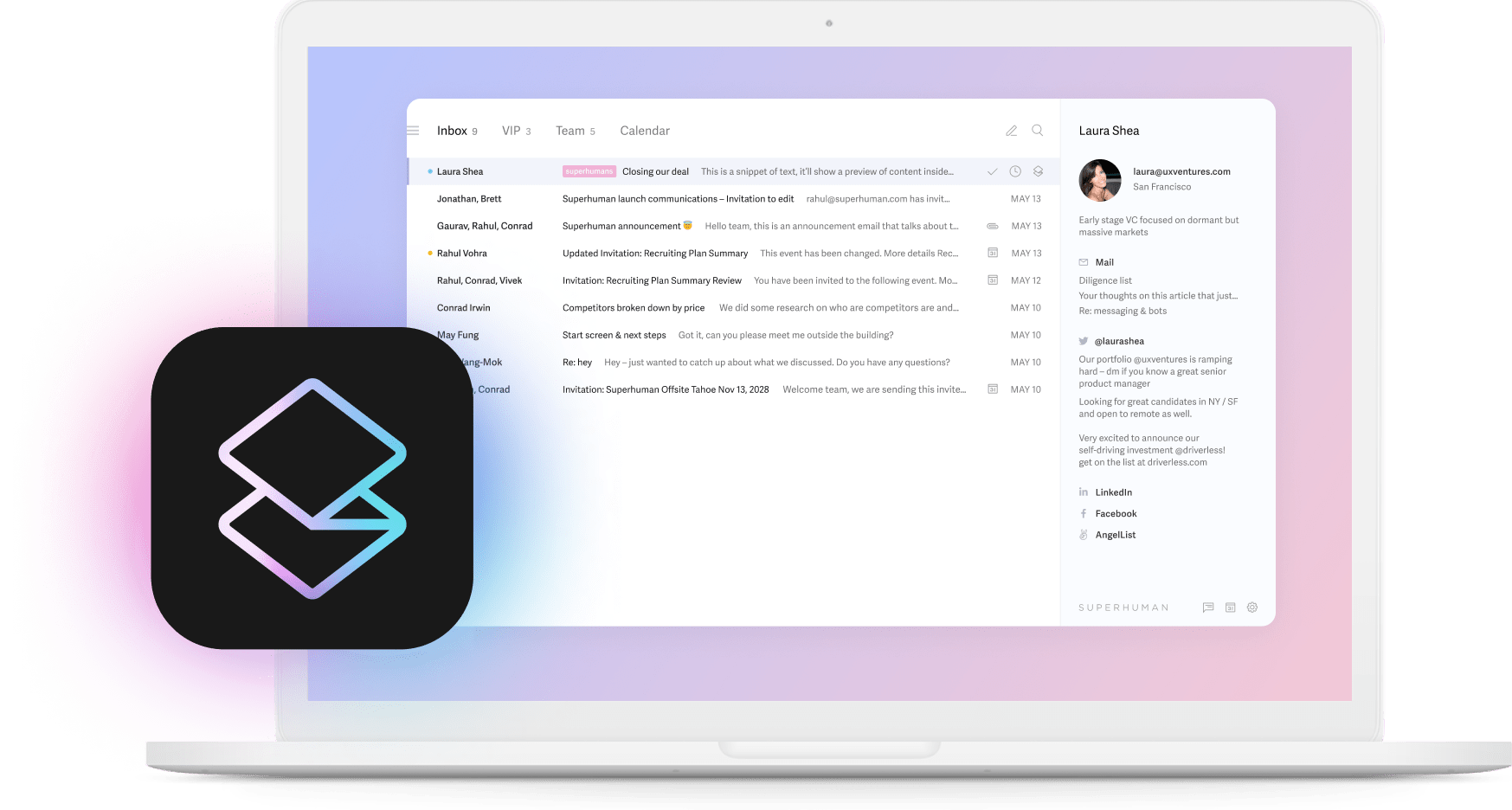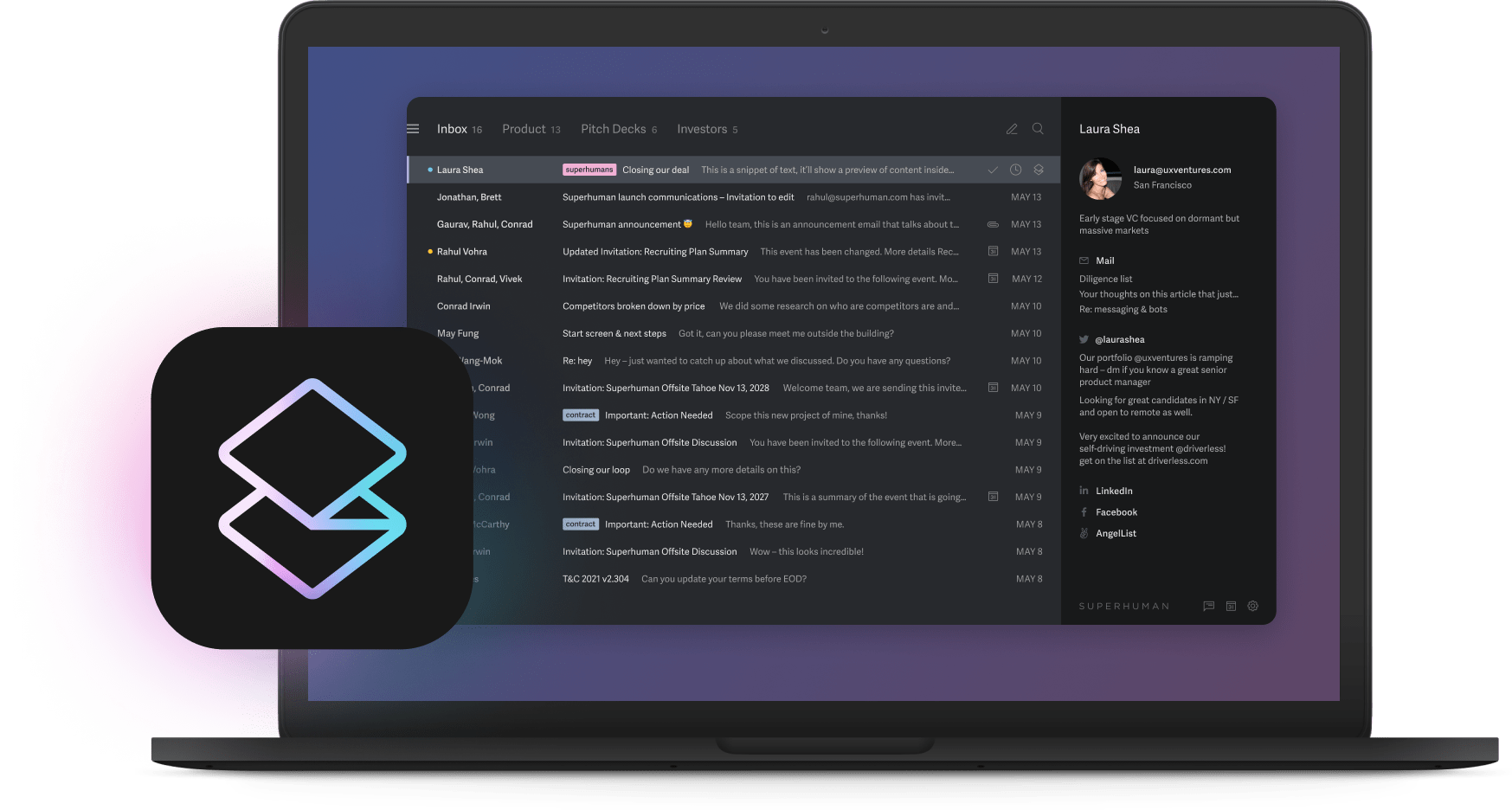
You're in a meeting when someone asks if anyone responded to the client yet. Three people say yes. Nobody checked if the others were already handling it. After the meeting, you discover all three sent different responses with conflicting information.
Your inbox holds 247 unread messages. Twelve need responses today. The rest? You'll find out when someone follows up asking why you didn't reply to their "urgent" message from Tuesday.
A designer spends three hours polishing an asset for the product launch. Later that day, another designer starts working on the same thing. The files were in different folders.
AI productivity tools promise to fix these problems. But thousands of AI apps exist, and most just add more noise to your workflow. The question isn't whether AI can help. It's which tools actually deliver results versus which ones look impressive in demos but fall apart when your team tries to use them.
This guide shows you tools that save real hours. Whether you're a founder juggling investor updates or a product leader coordinating launches, you need solutions that work immediately.
What matters when choosing an AI productivity tool
Walk into any company trying to "go AI" and you'll find the same pattern: excited leadership, skeptical teams, and a graveyard of half-implemented tools nobody uses. Most people pick tools based on what looks good on the pitch, not what works in practice.
Here's what separates tools you'll actually use from ones that sit abandoned in your app drawer.
Is it easy to use?
Your team won't adopt tools that require a PhD to operate. Everyone nods in the meeting. Two weeks later, three people are using it while everyone else finds workarounds.
The best tools feel natural from day one. Think about the difference between AI features buried in Settings > Advanced > AI Features > Enable versus suggestions that appear exactly when you need them. Can someone start using it productively within an hour? If you're checking help files constantly, the tool creates more work than it eliminates.
Does it integrate with your existing tools?
You shouldn't have to blow up your workflow to use a productivity tool. How well does this fit into your current setup with Slack, your CRM, Google Docs, and everything else you actually use?
Some tools are plug-and-play. Others force major transitions—migrate data, retrain your team, abandon systems you've built over years. Those transitions cost more time than the tool saves. Look for native integrations with platforms you already use.
Will it scale as your needs grow?
What works for your 10-person startup should still work when you hit 100 people. Can the tool process 50 emails per day and 500? Does it maintain speed when your document library grows from 100 files to 10,000? You don't want to switch platforms every time you hire a new team.
Is it cost effective?
Price tags don't tell the full story. Calculate true ROI: time saved, errors avoided, impact on productivity. A $30/month tool that saves your team 10 hours per week pays for itself immediately. A free tool that wastes 5 hours in setup and maintenance costs you money.
If someone earning $100/hour saves 4 hours weekly, even a $200/month tool delivers massive returns.
Is your data safe?
You're feeding these tools customer data, financial information, and strategic plans. The wrong tool puts your entire business at risk.
Look for end-to-end encryption, SOC 2 compliance, granular permissions, and transparent data handling policies. Where is your data stored? Who can access it? Does the AI model train on your sensitive information? Tools that treat security as an afterthought aren't worth considering.
Categories of AI productivity tools
You don't need dozens of tools. You need the right tools to solve your specific bottlenecks. From email overload to scattered documentation, the right combination transforms how your team works.
Let's break down the categories that matter most.
AI email productivity tools
Email is where productivity goes to die. Most professionals spend 2-4 hours daily managing their inbox. That doesn't count the mental overhead of deciding what to answer first or worrying about what you're missing.
The best AI email tools don't just organize chaos. They eliminate it. Here's how they save you hours every single day.
1. Superhuman Mail
Superhuman Mail uses AI-native features to automate replies, summaries, and keep you ahead of your inbox. It's built for people who receive 200+ emails daily and need to stay on top of everything without losing their minds.
You're clearing your inbox at 10pm on a Sunday. Again. The same messages keep piling up: investor updates that need thoughtful responses, customer escalations that can't wait, team questions that block their progress. You're typing the same explanations you've written a hundred times before.
Key features:
- Write with AI lets you type short phrases like "interested but need more details" and generates complete, professional emails that match your voice
- Instant Reply studies your writing patterns and creates responses so natural that people think you spent 10 minutes crafting them
- Split Inbox automatically separates important messages from noise, so you focus on what actually matters
- Auto-Summarize gives instant context when jumping into long email conversations—no more scrolling through 20 messages to understand what's happening
- Real-time Read Statuses show exactly when someone opened your email, perfect for timing follow-ups
- Reminders surface important messages at exactly the right time, so nothing falls through the cracks
Pros:
- Unmatched speed with every action happening in under 100 milliseconds
- AI-native writing features transform email from a time sink into your competitive advantage
- Saves 4+ hours per person every week with measurable productivity gains
- Teams respond 12 hours faster and handle twice as many emails in the same time
Cons:
- Premium pricing starts at $25/month, which may feel steep for casual email users
Best for: High-volume email users, startup founders drowning in investor updates, product leaders coordinating launches, and anyone who treats email as their primary business tool.
2. Gmail Gemini AI
Google's AI assistant Gemini integrates directly into Gmail, bringing AI capabilities to the platform most people already use. Smart Compose suggests sentences as you type, Smart Reply offers one-click responses, and Help Me Write generates draft emails from simple prompts.
Pros:
- Free with Google Workspace, making it accessible for teams on tight budgets
- Familiar interface means no learning curve for existing Gmail customers
Cons:
- AI features feel basic compared to dedicated email tools
- Limited customization options for power customers
- Works best only if you're fully committed to the Google ecosystem
Best for: Teams using Google Workspace who want basic AI assistance, small businesses on tight budgets, and anyone preferring incremental improvements.
3. SaneBox
SaneBox uses AI to analyze your email patterns and automatically sort messages into folders based on importance. It works with any email provider, learning what matters to you and filtering out noise through features like SaneLater and SaneBlackHole.
Pros:
- Works with any email provider, so you keep your existing setup
- Learns your preferences over time and gets smarter with use
Cons:
- Takes a week or two to learn your patterns effectively
- Important emails occasionally get filtered incorrectly
- Pricing starts at $7/month
Best for: People who want inbox cleanup without changing email clients and professionals dealing with high volumes of newsletters.
Writing and content creation AI productivity tools
Writing is hard enough without fighting grammar issues, finding the right tone, or staring at a blank page wondering how to start. AI writing tools handle the technical details while you focus on your message.
4. Grammarly
You're about to send an important email to a potential client when you notice something feels off. The tone sounds harsher than you intended. A sentence runs on too long. There's probably a typo you missed.
Grammarly catches complex grammar mistakes, suggests tone adjustments, and keeps your business writing consistent. It's the writing assistant that makes sure you never send an email with embarrassing errors or confusing phrasing. Many teams use Grammarly alongside tools like Superhuman Mail and Coda to maintain professional communication standards across all their work.
Key features:
- Advanced grammar checking catches mistakes most people miss
- Tone detection analyzes how your writing comes across and suggests improvements
- Clarity suggestions help simplify complex sentences
- Plagiarism checker ensures originality in important documents
- Style consistency maintains uniform formatting across documents
Pros:
- Works everywhere through browser extensions, catching errors across all your tools
- Catches sophisticated writing problems that basic spell-check misses
- Improves your writing skills over time as you learn from suggestions
- Free version handles basics; Premium at $12/month unlocks advanced features
Cons:
- Sometimes suggests overly formal language that doesn't fit casual contexts
- Creative writers may find the suggestions limiting
Best for: Professional writing where you can't afford to look unprofessional, anyone lacking confidence in their writing, teams that need consistent communication standards, and non-native English speakers.
5. Jasper
Jasper is an AI writing platform built for marketing teams and businesses that need consistent, on-brand content at scale. Brand Voice learns your company's tone, templates speed up content creation, and the long-form editor helps create comprehensive articles with SEO integration.
Pros:
- Excellent for teams creating large volumes of marketing content
- Strong brand consistency features ensure on-brand messaging
Cons:
- Requires clear prompts to generate quality output
- Pricing starts around $49/month per seat, making it expensive for individuals
Best for: Marketing teams, content agencies, small businesses without dedicated writers, and anyone producing consistent, on-brand content quickly.
Task and project management AI productivity tools
Traditional project management collapses when reality hits. Priorities shift, deadlines change, team members get pulled into urgent issues, and suddenly your carefully organized plan becomes worthless. AI-powered task and project management tools adapt to chaos instead of breaking under it.
6. Coda
Coda turns documents into living, breathing workspaces where your team can collaborate in real time. You're writing a product spec when someone asks about timeline updates. Instead of switching to another tool, you update the timeline right in the same document. The changes sync instantly across your team.
Coda's AI features help teams using tools like Superhuman Mail and Grammarly bring the same level of intelligent automation to their documentation and project planning. The platform combines the flexibility of docs with the power of databases and automation.
Key features:
- AI-powered writing generates and refines content within documents
- Smart tables create connected databases that update automatically
- Automation builder triggers actions based on document changes
- Templates and packs provide pre-built solutions for common workflows
- Real-time collaboration keeps teams aligned without version control headaches
Pros:
- Incredibly flexible for teams that want to build custom solutions
- Strong automation capabilities reduce manual work
Cons:
- The flexibility means there's a learning curve to get started
- Teams need to invest time in setting up their workflows properly
Best for: Teams tired of juggling multiple tools, product managers building living roadmaps, operations teams creating custom workflows, and organizations that need more power than traditional docs but don't want separate database tools.
7. Asana
Asana uses AI to help plan, assign, and automate tasks based on intelligent priorities. Smart task assignments suggest the right person based on workload, automated workflows trigger actions at certain stages, and timeline optimization adjusts schedules when deadlines shift.
Pros:
- Powerful for complex projects with multiple dependencies
- Strong integrations with other productivity tools
Cons:
- Learning curve can be steep for teams new to structured project management
- Pricing ranges from free for basic use to $24.99 per seat/month for advanced features
Best for: Product teams coordinating feature launches, project managers handling complex initiatives with multiple stakeholders, and teams needing sophisticated task dependencies.
8. Notion AI
Notion AI brings AI-assisted knowledge management to the platform many teams already use. AI writing assistance generates drafts and expands ideas, automatic summaries condense long documents, and Q&A functionality answers questions using your team's knowledge base.
Pros:
- Seamlessly integrates with existing Notion workspaces
- Democratizes access to company knowledge across teams
Cons:
- AI features require paid plans at $10/month per seat
- Works best when documentation is already well-organized
Best for: Remote teams working across time zones, companies with extensive documentation needs, and teams already using Notion who want AI capabilities.
Note-taking and meetings AI productivity tools
You're in a crucial call, trying to listen, participate, and take notes all at once. You end up doing none of them well. Meeting AI tools solve this problem by handling transcription, identifying action items, and creating summaries automatically.
9. Otter.ai
Otter.ai automatically transcribes meetings with impressive accuracy, capturing every word while identifying different speakers. Real-time transcription lets you focus on conversation, keyword summaries highlight important topics, and shared notes allow team collaboration. Mobile apps let you capture conversations anywhere.
Pros:
- Highly accurate transcription across multiple platforms
- Makes meeting content searchable for future reference
Cons:
- Occasionally struggles with heavy accents or poor audio quality
- Free tier offers 300 monthly minutes; paid plans start at $16.99/month
Best for: Remote teams, professionals in back-to-back meetings, anyone needing meeting documentation, and teams wanting searchable conversations.
10. Fireflies.ai
Fireflies.ai automatically joins your meetings across Zoom, Teams, and Google Meet, then creates comprehensive documentation without human intervention. It extracts action items, tracks meeting analytics, and integrates with CRMs to automatically log notes.
Pros:
- Sophisticated action item detection saves hours of manual follow-up
- Seamless platform integration works across all major meeting tools
Cons:
- The AI joining meetings can feel intrusive if participants aren't expecting it
- Pricing starts around $10/seat/month
Best for: Sales teams who need meeting notes in their CRM, product managers conducting user research, and remote teams coordinating across time zones.
Research and search assistants AI productivity
You open 47 browser tabs trying to research a topic. Twenty minutes later, you're reading about something completely different and you've forgotten your original question. Traditional search dumps results and expects you to connect the dots.
AI research assistants understand what you're asking, synthesize information from multiple sources, and deliver complete answers with proper citations.
11. Perplexity AI
Perplexity provides real-time, source-cited answers drawn from a broad knowledge base. Conversational search lets you ask follow-up questions naturally, source citations show exactly where information comes from, and Pro Search delivers comprehensive answers for complex questions.
Pros:
- Fast, reliable answers with verifiable sources
- Saves massive amounts of research time compared to traditional search
Cons:
- Sometimes focuses too narrowly on specific aspects of broad questions
- Free tier available; Pro costs $20/month
Best for: Researchers who need reliable information quickly, analysts gathering competitive intelligence, and anyone who values source transparency.
12. Notebook LM
Notebook LM extracts and summarizes user-uploaded content for deep research. Document grounding creates answers based solely on your uploaded materials, and multi-document analysis synthesizes information across multiple sources with citation tracking.
Pros:
- Excellent for working with proprietary or specialized content
- Ensures answers come from your trusted sources only
Cons:
- Limited by the quality and completeness of uploaded documents
- Currently free from Google, but this may change
Best for: Researchers analyzing academic papers, legal professionals reviewing case documents, and consultants working with client materials.
Image and video creation AI productivity
You need a quick graphic and suddenly you're two hours deep in design tools, trying to remember how layers work. Or you want to create an explainer video but hiring a production team costs thousands.
AI multimedia tools democratize visual content creation, producing professional results in minutes regardless of your design skills.
13. Magic Studio
Magic Studio delivers fast image editing and enhancement using AI. Background removal, image enhancement, object removal, and batch processing handle multiple images simultaneously with simple text commands. Style transfer applies artistic effects consistently across images.
Pros:
- Incredibly fast for common image tasks
- Intuitive interface requiring no design skills
Cons:
- Limited creative control compared to professional tools
- Pricing varies by usage
Best for: Social media managers creating content at scale, e-commerce businesses processing product photos, and anyone wanting professional-looking images without design expertise.
14. Animaker AI
Animaker AI converts scripts into animated explainer videos in minutes. Text-to-video creates animations from written scripts, character customization offers diverse options, and voice generation adds AI voiceovers in multiple languages with millions of stock assets.
Pros:
- Dramatically speeds up explainer video creation
- Makes animation accessible to non-designers
Cons:
- AI-generated videos can look generic without customization
- Plans start around $12.50/month
Best for: Marketing teams creating explainer content, educators developing course materials, and startups pitching concepts visually.
Your implementation plan for AI productivity tools that work
Don't collect AI tools like trading cards. Every tool you add creates more complexity. The goal is solving real problems, not assembling an impressive tech stack.
Identifying top time drains
Track where you actually lose time for one week. Don't guess. Use time blocks in your calendar to categorize every hour: email, meetings, documentation, research, administrative tasks. Calculate totals at week's end.
Write down your top three time drains with actual hours attached. "Email" isn't specific enough—is it reading? Writing responses? Searching for information? If a tool can't save you at least one hour daily on your biggest time drain, it's not worth implementing.
Piloting new tools with adaptable team members
Pick 2-3 tools targeting your biggest time drains. Start with tech-savvy people who embrace change. Give them 30 days to test alongside existing workflows, not replacing them.
Set clear success metrics before starting. Can the email tool cut response time by 50%? Does the meeting tool eliminate Sunday planning sessions? Track weekly. When your pilot group shares real results—"I saved 6 hours this week"—skeptical team members pay attention.
Defining clear success metrics
Prove ROI with hard numbers before rolling out broadly. Sample metrics: percentage less time spent on email, hours saved per week per person, reduction in missed action items, faster response times.
If someone earning $100/hour saves 10 hours weekly, a $30/month tool pays for itself immediately.
Building a stack
Focus on interoperability and value. The best productivity stacks consist of tools that work together seamlessly. Superhuman Mail for email, Motion for scheduling, and Zapier for automation create a flywheel where each tool amplifies the others. Many teams add Grammarly for writing consistency and Coda for collaborative documentation.
Avoid redundancy. Pick the best solution for each category and integrate properly. One tool that works perfectly beats three half-implemented solutions.
Training, documentation, ongoing evaluation
Create simple training documentation. Short videos showing specific use cases work better than comprehensive guides. Focus on the 20% of features that deliver 80% of value.
Roll out one tool at a time. Space launches by 2-4 weeks, giving people time to build new habits. Evaluate quarterly. Cut what doesn't work rather than forcing adoption of tools that aren't delivering results.
Save time with the fastest AI email
The biggest time wins come from combining well-chosen tools, especially for communication bottlenecks. Email remains the primary productivity killer for most professionals, and fixing it unlocks hours every single day.
Superhuman Mail stands out as the fastest way to clear email overload. While other tools help you organize chaos, Superhuman Mail eliminates it. The combination of Write with AI, Instant Reply, Auto-Summarize, and intelligent inbox management transforms email from a time sink into your competitive advantage.
When you're saving 4 hours per person every week, suddenly that premium price tag becomes irrelevant. Calculate what your team's time is worth. Then calculate what 4 hours weekly per person adds up to over a year. The ROI isn't just positive, it's dramatic.
The professionals winning today automate operational tasks while focusing human energy on innovation and relationships. Your transformation starts with your next email, meeting, or content piece.
Pick one AI tool from this guide. Try it this week. Track the time you save. Then add another tool targeting your next biggest bottleneck. Build your stack deliberately, measuring results as you go.
Ready to reclaim your inbox? Try Superhuman Mail and discover why thousands of executives, founders, and busy professionals trust it to save hours every single day.





